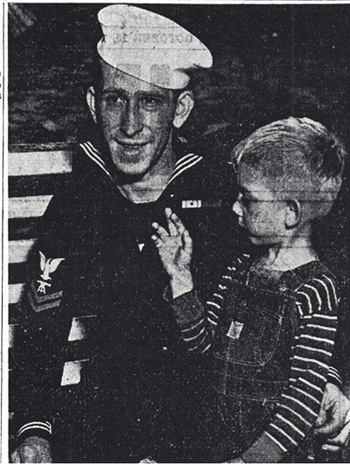SAILOR IS SAFE
A telephone call from Melvin L. Foster, son of Mrs. Ethel Madsen, 3214 Fourth avenue place, Tuesday night, brought relatives the first word from him in over two months. Foster, a second class petty officer in the Navy, said he was at a receiving station in San Francisco awaiting transfer to another ship.
Source: The Sioux City Journal, September 16, 1942
![]()

Here Petty Officer Melvin Foster, 24, second class, a fire control man aboard the Astoria, one of three heavy cruisers lost in the Solomon islands attack, described the nighttime naval battle for Billy Dickinson, his 4-year-old nephew. With the Japs on the third day opening at 6,000 yards in the light of flares dropped from planes, the Yanks gave them “as good as was sent” and after the battle, the American range finder said “our salvos could be seen hitting their amidships.”The finder said, “we saw ships afire but we could not identify them.”At this point in the graphic description, Billy asks about the decoration earned for “combat and good conduct” appearing on the young sailor’s uniform. Petty Officer Foster had been on the Astoria, a 9,950-tonner carrying a normal complement of 49 officers and 850 enlisted men, for about three years. He is at home, 3214 Fourth Avenue place, on leave. |
DESCRIBES SINKING OF AMERICAN CRUISERS
Sioux Cityan Who Was on Astoria Tells of Experience
“The Japs opened up at 6,000 yards with no chance to miss when they lighted us up with flares dropped from planes.”
Such was the vivid description of the third of the three-day battle in the Solomon island action which cost three heavy United States cruisers by Petty Officer Melvin Foster, 24, at his home, 3214 Fourth avenue place.
On a 30-day leave, the young sailor and fire control man aboard the Astoria, a 9,950-tonner, described the engagement during which his ship, the U. S. S. Quincy and the 9,400-ton Vincennes were lost.
“I had the 8 to 12 watch midnight,” began the officer as he described while resting in the yard of his home the beginning of the third day of the battle between a Japanese naval force and an American naval force endeavoring to screen the landing of marines on Guadalcanal island.
AWAKENED EARLY.
“After being relieved, I was asleep on the top side instead of below decks as usual. About 1:50 a.m. a marine came over, gave me a shove and said that planes were dropping flares.
“I had no sooner got to the battle station than the Japs began firing. Two salvos straddled us. One went over us and the other fell short.
“Our ship had opened fire before general quarters was sounded. The next salvo hit and others followed. The Astoria, however, fired first and last salvos of the allied cruisers.
“The Japs were using destroyers and cruisers in this stage of the action. We shot out their searchlights but it was too late. They already had us afire.”
JAPS SEND BOMBERS.
With the Astoria drawn up in the channel between Guadalcanal and the Tulagi islands, the first two days of the battle were given over to air attacks. He said in the second day the Japs sent in their 97 “Mits” bombers.
During the latter stages of battle, their attacks were of shell fire torpedoes. He said the Astoria burned throughout the night of August 9 up to 11:30 a.m. the following day when “she had an internal explosion, rolled to port and sank. When she went down 250 of her crew were still fighting fires.”
The young officer said that the doctors on the transports following the engagement “did a wonderful job treating the wounded with the facilities at hand.”
Best description of the battle, he said, came from War Correspondent, Joe Custer, wounded while aboard the Astoria. Foster quoted Custer as calling the engagement “a tennis match in hell.”
Source: The Sioux City Journal, October 15, 1942 (photo included)
![]()
